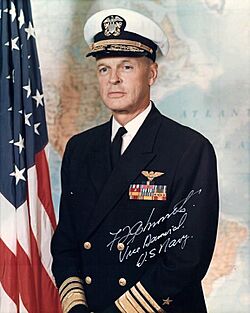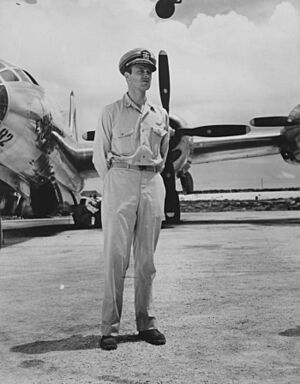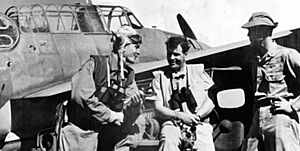Frederick Ashworth facts for kids
Quick facts for kids
Frederick Lincoln Ashworth
|
|
|---|---|
 |
|
| Nickname(s) | "Dick" |
| Born | 24 January 1912 Beverly, Massachusetts |
| Died | 3 December 2005 (aged 93) Phoenix, Arizona |
| Allegiance | |
| Service/ |
|
| Years of service | 1933–1968 |
| Rank | |
| Service number | 0-72354 |
| Commands held | Sixth Fleet |
| Battles/wars | World War II:
|
| Awards | Distinguished Service Medal (2) Silver Star Legion of Merit (2) Bronze Star Medal |
Frederick Lincoln "Dick" Ashworth (born January 24, 1912 – died December 3, 2005) was an officer in the United States Navy. He is best known for his role as the "weaponeer" on the B-29 plane Bockscar. This plane dropped the "Fat Man" atomic bomb on Nagasaki, Japan, on August 9, 1945, during World War II.
Ashworth graduated from the United States Naval Academy in 1933. He led Torpedo Squadron Eleven (VT-11), a Grumman TBF Avenger unit. This squadron flew important missions from Guadalcanal in the Solomon Islands. These missions supported the New Georgia Campaign. He earned the Distinguished Flying Cross for his bravery. Later, he worked as an aviation officer for Vice Admiral Richmond K. Turner during the Gilbert and Marshall Islands campaign.
In June 1944, Ashworth returned to the United States. He became a senior naval aviator at the Naval Proving Ground in Virginia. In November 1944, he joined the top-secret Manhattan Project. He oversaw tests of atomic bomb parts at Wendover Air Force Base. In February 1945, he helped choose Tinian as the main base for the 509th Composite Group. This group was responsible for dropping the atomic bombs. After the war, he also helped pick Bikini Atoll for Operation Crossroads, which were atomic bomb tests.
Ashworth stayed in the Navy after the war. He rose to the rank of vice admiral in May 1966. He was in charge of the United States Sixth Fleet from September 1966 to April 1967. He retired from the Navy in 1968 and passed away in 2005.
Contents
Growing Up and Early Career
Frederick Lincoln "Dick" Ashworth was born in Beverly, Massachusetts, on January 24, 1912. He was the third child of Fred and Minnie Ashworth. His father worked as a designer for a shoe machinery company. Dick had two older brothers, Phil and Bentley. Phil also went to the United States Naval Academy but sadly died in a seaplane crash in 1938.
In 1918, his family moved to a farm in Wenham, Massachusetts. Dick went to Center School in Wenham. Since Wenham did not have a high school, he attended Beverly High School. He was president of the Student Council there. He was too young for football but enjoyed track and cross country running. After graduating in 1928, he went to Dartmouth College.
Ashworth decided he wanted to join the Navy like his brother. He passed the entrance exams for the Naval Academy. In August 1929, he got a spot at Annapolis, Maryland. He graduated in 1933 and became an ensign, a junior officer rank.
Fighting in the Solomon Islands
Ashworth's first assignment was on the battleship USS West Virginia. In June 1935, he married Nathalie Louise Bliss. They had three sons: Frederick Jr., David, and Stephen. In 1936, he started training to become a naval aviator (pilot). He then held various roles, including air photography officer for the United States Pacific Fleet. In 1939, he studied further at Annapolis to become an aviation ordinance engineer.
By the time Ashworth finished his studies in June 1942, the United States had entered World War II. He became the leader of Torpedo Squadron Eleven (VT-11). This squadron flew Grumman TBF Avenger planes from Guadalcanal. Their missions included patrols, searches, and dropping mines at night. These actions helped support the New Georgia Campaign in the Solomon Islands. For his brave actions, Ashworth received the Distinguished Flying Cross and the Bronze Star Medal.
In September 1943, Ashworth joined the staff of Vice Admiral Richmond K. Turner. He served as the aviation officer for the V Amphibious Force. In this role, he took part in the Gilbert and Marshall Islands campaign.
The Atomic Bomb Project

In June 1944, Ashworth returned to the United States. He became a senior naval aviator at the Naval Proving Ground in Virginia. In November, he was assigned to the top-secret Manhattan Project. This project was developing the atomic bomb. Ashworth's job was to supervise the testing of bomb parts at Wendover Air Force Base. He helped the engineers work smoothly with the base commander.
As a commander, he became the Director of Operations for Project Alberta. This part of the Manhattan Project was in charge of dropping the atomic bombs on Japan. In February 1945, Ashworth went to Guam. He delivered a letter to Fleet Admiral Chester Nimitz, asking for full support for the Manhattan Project. Ashworth's first task was to choose a good base for the 509th Composite Group. After looking at Guam and Saipan, he picked Tinian. Tinian was closer to Japan and had better facilities.
The head of the Manhattan Project, Major General Leslie R. Groves, Jr., wanted each atomic bomb mission to have a "weaponeer." This was a military academy graduate who would fly on the bomb plane. The weaponeer would make important decisions during the mission. Only two officers fit this role: Ashworth and his commander, Captain William S. Parsons. They decided to take turns leading missions. Parsons led the Hiroshima mission. Ashworth led the Nagasaki mission. For his actions on the Nagasaki mission, Ashworth received the Silver Star Medal. He also received the Legion of Merit for his work on the atomic bomb project.
Ashworth received a second Legion of Merit in 1946 for his work on Operation Crossroads. This was a series of atomic bomb tests after the war. He helped organize the military and technical teams for these tests. He also helped choose Bikini Atoll as the test site.
After the War and Retirement
Ashworth continued his career in the Navy after World War II. From 1952 to 1954, he worked for the United States Atomic Energy Commission. In 1958, he was the Commandant of Midshipmen at the United States Naval Academy. From 1958 to 1960, he led the Atomic Energy Division for the Chief of Naval Operations.
In May 1966, he was promoted to vice admiral. He commanded the United States Sixth Fleet from September 1966 to April 1967. For this, he earned a Navy Distinguished Service Medal. From April 1967 to September 1968, he was a Deputy Commander in Chief for the U.S. Atlantic Fleet. He earned a second Navy Distinguished Service Medal for this role. He retired in September 1968 as a vice admiral.
Frederick L. Ashworth lived in Santa Fe, New Mexico, for over 30 years. He divorced his first wife in 1990 and remarried. He passed away on December 3, 2005, in Phoenix, Arizona, during heart surgery. He was buried in the Santa Fe National Cemetery. He was survived by his second wife, Ercie Bell Ashworth, and his three sons.
Awards and Decorations
Vice Admiral Ashworth received many awards for his service, including:
- Navy Distinguished Service Medal (twice)
- Silver Star
- Legion of Merit (twice)
- Distinguished Flying Cross
- Bronze Star Medal
- American Defense Service Medal
- American Campaign Medal
- Asiatic-Pacific Campaign Medal (with four service stars)
- World War II Victory Medal
- China Service Medal
- National Defense Service Medal (with one service star)
Images for kids


